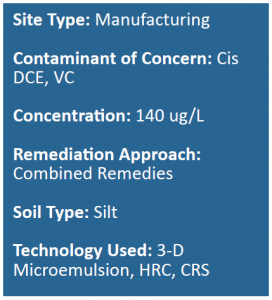Active Manufacturing Facility Remediated to Compliance Levels
Extensive Chlorinated Solvents Contamination Treated with Combined Remedies
Project Highlights
- Active manufacturing and low permeability soil caused application limitations.
- Combined use of 3-D Microemulsion®, Hydrogen Release Compound® (HRC) and Chemical Reducing Solution® (CRS) were used for the remediation approach.
- Significant reductions were observed in TCE, DCE and VC post-application.
- Site closure is pending regulatory approval.

Project Summary
The site, located in Southern New Hampshire, was contaminated with chlorinated solvents in soils, groundwater and surface water beneath and adjacent to a former industrial facility. After investigations to characterize the extent of contamination beneath and adjacent to the industrial facility caused by spills and aggravated by leaks in a storm drain underlying the building, a remedial action was designed and implemented. HRC applications were completed February 2008 and March 2011 to reduce cVOC levels in groundwater. The site had limitations that included reduced access because of active manufacturing inside the building and soil had reduced permeability. Significant reductions were observed in TCE, DCE and VC after the application. However, two wells remained above standards for DCE and VC with the assumption that HRC was not adequately distributed in that area. An application of 3-D Microemulsion® and CRS® was completed in May 2013. Significant reductions of DCE and VC were observed and levels were rapidly brought into compliance.
Remediation Approach
HRC was applied to stimulate the biodegradation of chlorinated solvents. Permanent re-injection points were installed in a grid layout so as to make it easy for re-application without additional construction or drilling activities. Surface water contamination was caused by contaminated groundwater leaking into the storm drain with discharge to the headwaters of a small stream downgradient of the facility. The contamination was addressed by air sparging within the drain pipe near the discharge point but before water discharged to the stream. The discovery of soil contamination causing low level groundwater contamination was addressed by excavating the soil source and disposing the soil off-site.
In the first three years after HRC injection, ¾ of the site was remediated at three source locations. One source area beneath the building exhibited persistent groundwater contamination. The remaining contamination appears to have been caused by poor HRC distribution resulting from underground cement blocks and low permeability soils. 3-D Microemulsion and CRS were injected at two locations surrounding where hot spots of 1,2-DCE and VC persisted at high levels. Recent measurements show significant reductions in the groundwater contamination indicating successful bio-stimulation of chlorinated solvent degraders in the hot spot areas.
Currently the site is under a Groundwater Management Permit which establishes a Groundwater Management Zone with eleven monitoring wells and one surface water monitoring point. Recent monitoring results show dramatic decreases in groundwater concentrations at the location of contamination persistence, and site closure is now projected to occur in the near future.
Technology Description
3-D Microemulsion factory emulsified is an engineered electron donor material that offers a novel 3-stage electron donor release profile, pH neutral chemistry and is delivered on-site as a factory–emulsified product.
HRC is a controlled release, electron donor material, that when hydrated is specifically designed to produce a controlled release of lactic acid. The newly available lactic acid is critical for the production of hydrogen to fuel anaerobic biodegradation processes in soil and groundwater.
CRS (Chemical Reducing Solution) is an iron-based amendment for in situ chemical reduction (ISCR) of halogenated hydrocarbon contaminants such as chlorinated ethenes and ethanes.


 Americas
Americas Europe
Europe Français
Français Deutsch
Deutsch Italiano
Italiano Español
Español


